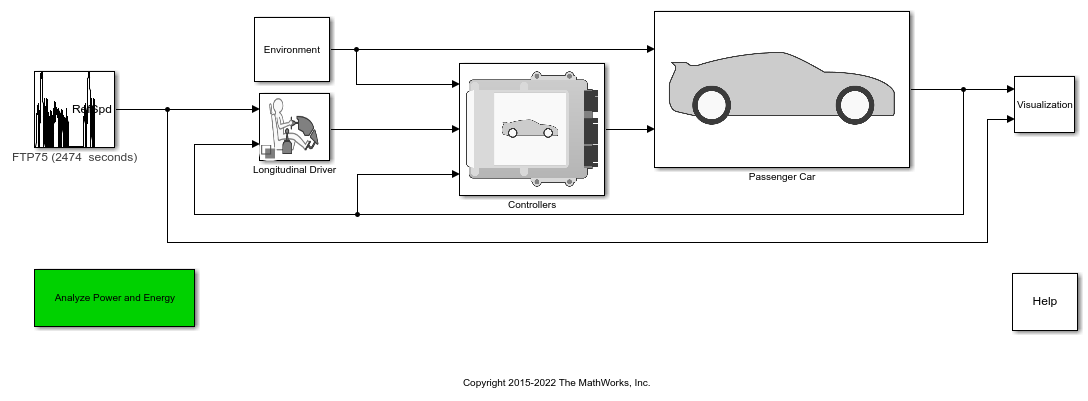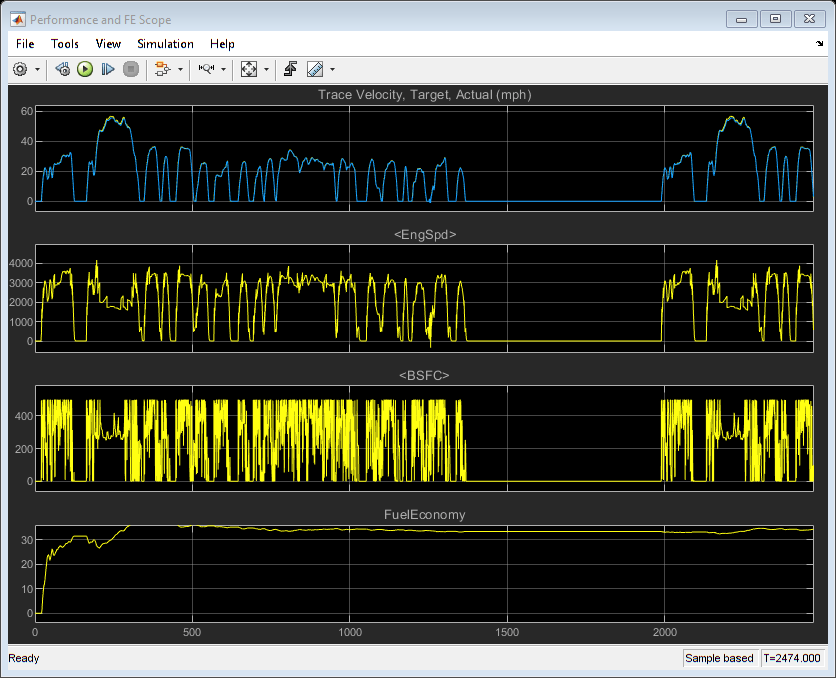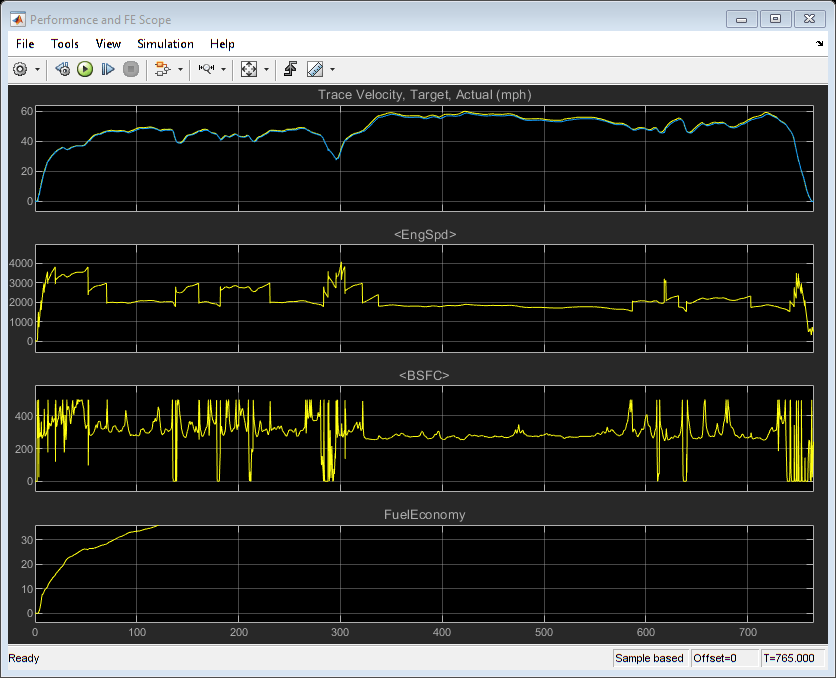Conventional Vehicle Spark-Ignition Engine Fuel Economy and Emissions
This example shows how to calculate the city and highway fuel economy and the emissions for a conventional vehicle with a 1.5-L spark-ignition (SI) engine. To run this example, make sure you have the city (FTP75) and the highway (HWFET) drive cycles installed. After you open the conventional vehicle reference application, open the Drive Cycle Source block and click Install additional drive cycles. For more information, see Install Drive Cycle Data.
setupconvehMPG;

Prepare the Conventional Vehicle Reference Application for Simulation
Name the Drive Cycle Source block and Visualization subsystem.
model = 'SiCiPtReferenceApplication'; dcs = [model, '/Drive Cycle Source']; vis_sys = [model, '/Visualization'];
In the Visualization subsystem, log the emissions signal data.
pt_set_logging([vis_sys, '/Performance Calculations'], 'US MPG', 'Fuel Economy [mpg]', 'both'); pt_set_logging([vis_sys, '/Emission Calculations'], 'TP HC Mass (g/mi)', 'HC [g/mi]', 'both'); pt_set_logging([vis_sys, '/Emission Calculations'], 'TP CO Mass (g/mi)', 'CO [g/mi]', 'both'); pt_set_logging([vis_sys, '/Emission Calculations'], 'TP NOx Mass (g/mi)', 'NOx [g/mi]', 'both'); pt_set_logging([vis_sys, '/Emission Calculations'], 'TP CO2 Mass (g/km)', 'CO2 [g/km]', 'both');
Run City Drive Cycle Simulation
Configure the Drive Cycle Source block to run the city drive cycle (FTP75).
set_param(dcs,'cycleVar','FTP75');
Run a simulation of the city drive cycle. View the results in the Performance and FE Scope.
tfinal = get_param(dcs, 'tfinal'); tf = tfinal(1:strfind(tfinal,' ')); save_system(model); simout1 = sim(model,'ReturnWorkspaceOutputs','on', 'StopTime', tf); open_system('SiCiPtReferenceApplication/Visualization/Performance and FE Scope')
### Starting serial model reference simulation build. ### Model reference simulation target for DrivetrainConVeh is up to date. ### Model reference simulation target for PowertrainBestFuelController is up to date. ### Model reference simulation target for SiEngineController is up to date. ### Model reference simulation target for SiMappedEngine is up to date. Build Summary 0 of 4 models built (4 models already up to date) Build duration: 0h 0m 15.576s

The results indicate that the fuel economy is approximately 34 mpg at the end of the drive cycle. The scope also provides the target velocity, engine speed, and brake specific fuel consumption (BSFC).
Run Highway Drive Cycle Simulation
Configure the Drive Cycle Source block to run the highway drive cycle (HWFET). Make sure that you have installed the highway drive cycle.
set_param(dcs,'cycleVar','HWFET');
Run a simulation of the highway drive cycle. View the results in the Performance and FE Scope.
tfinal = get_param(dcs, 'tfinal'); tf = tfinal(1:strfind(tfinal,' ')); save_system(model); simout2 = sim(model,'ReturnWorkspaceOutputs','on', 'StopTime', tf); open_system('SiCiPtReferenceApplication/Visualization/Performance and FE Scope')
### Starting serial model reference simulation build. ### Model reference simulation target for DrivetrainConVeh is up to date. ### Model reference simulation target for PowertrainBestFuelController is up to date. ### Model reference simulation target for SiEngineController is up to date. ### Model reference simulation target for SiMappedEngine is up to date. Build Summary 0 of 4 models built (4 models already up to date) Build duration: 0h 0m 2.2473s

The results indicate that the fuel economy is approximately 45 mpg at the end of the drive cycle. The scope also provides the target velocity, engine speed, and brake specific fuel consumption (BSFC).
Extract Results
Extract the city and highway fuel economy results for the city and highway drive cycles from the logged data.
logsout1 = simout1.get('logsout'); FE_urban = logsout1.get('Fuel Economy [mpg]').Values.Data(end); logsout2 = simout2.get('logsout'); FE_hwy = logsout2.get('Fuel Economy [mpg]').Values.Data(end);
Use the city and highway fuel economy results to compute the combined sticker mpg.
FE_combined = 0.55*FE_urban + 0.45*FE_hwy;
Extract the tailpipe emissions from the city drive cycle.
HC = logsout1.get('HC [g/mi]').Values.Data(end); CO = logsout1.get('CO [g/mi]').Values.Data(end); NOx = logsout1.get('NOx [g/mi]').Values.Data(end); CO2 = logsout1.get('CO2 [g/km]').Values.Data(end);
Display the fuel economy and city drive cycle tailpipe emissions results in the command window.
fprintf('\n***********************\n') fprintf('FUEL ECONOMY\n'); fprintf(' City: %4.2f mpg\n', FE_urban); fprintf(' Highway: %4.2f mpg\n', FE_hwy); fprintf(' Combined: %4.2f mpg\n', FE_combined); fprintf('\nTAILPIPE EMISSIONS\n'); fprintf(' HC: %4.3f [g/mi]\n',HC); fprintf(' CO: %4.3f [g/mi]\n',CO); fprintf(' NOx: %4.3f [g/mi]\n',NOx); fprintf(' CO2: %4.1f [g/km]\n',CO2); fprintf(' NMOG: %4.3f [g/mi]',HC+NOx); fprintf('\n***********************\n');
*********************** FUEL ECONOMY City: 34.29 mpg Highway: 45.18 mpg Combined: 39.19 mpg TAILPIPE EMISSIONS HC: 0.001 [g/mi] CO: 0.000 [g/mi] NOx: 0.001 [g/mi] CO2: 158.0 [g/km] NMOG: 0.002 [g/mi] ***********************
